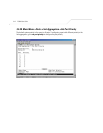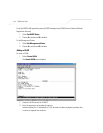
Administration Console Access
3-43
3.5.29 Main Menu>VLANs
A Virtual Local Area Network (VLAN) is a means to electronically separate ports on the same switch
from a single broadcast domain into separate broadcast domains. By using a VLAN, users can group
by logical function instead of physical location. There are 4096 VLANs supported on this switch. Two
memberships are available for a VLAN member, tagged and untagged, abbreviated as T and U,
respectively. If a port is an untagged member of a VLAN, the VLAN tag is striped from the frame
before it is sent out that port. If the port is a tagged member of a VLAN, the VLAN tag stays in the
frame when sent. If a port is not a member of the particular VLAN, it does not get any traffic for that
VLAN. The VLAN tagging option is a standard set by the IEEE to facilitate the spanning of VLANs
across multiple switches.
All untagged packets entering the switch by default are tagged with the ID specified by the port ID.
Use the VLAN screen to specify the VLAN ID for each port. The number next to each port indicates
which ID is set for each port. Following industry standards, ID 1 is the default ID.
Up to 4094 VLANs with unique ID numbers and names can be added. VLAN ID numbers are required
to be within 1-4094. Per industry standard, the default VLAN has an ID of 1.
VLAN ID #1 cannot be deleted under any circumstance.


















